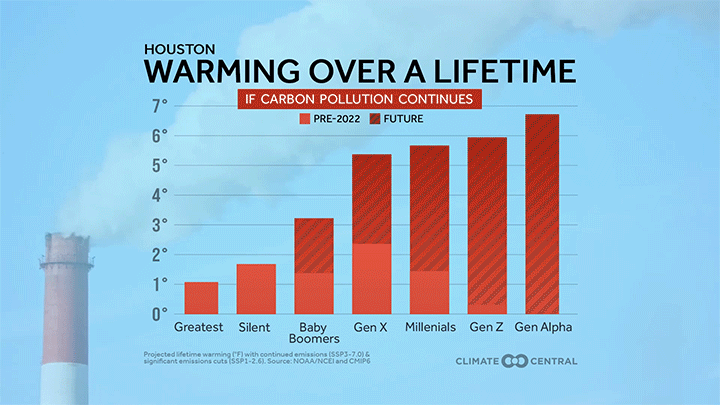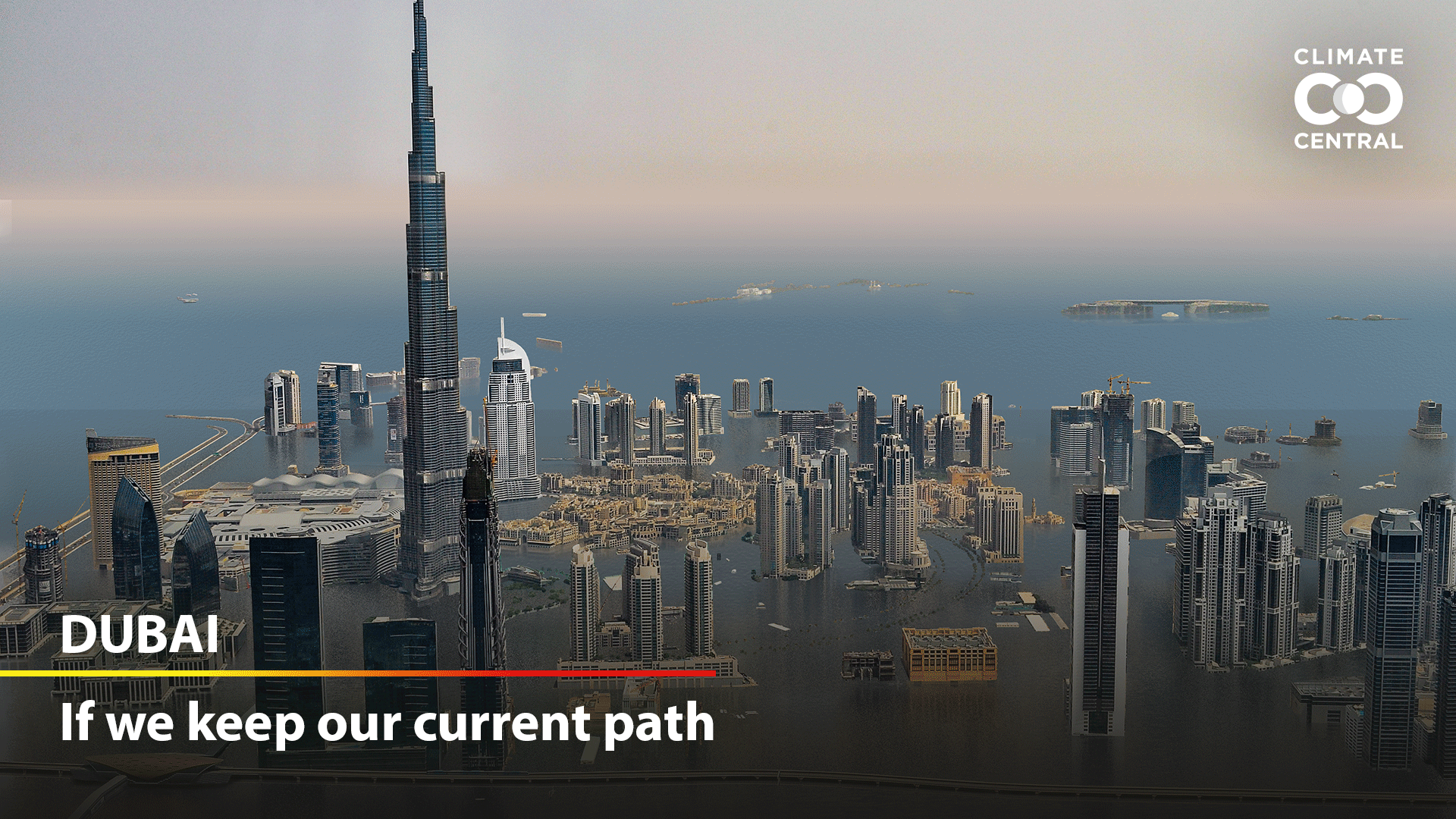Climate Matters•November 29, 2023
COP28: Global Climate Conference
KEY CONCEPTS
COP28, the U.N. climate conference starting November 30, aims to close the gap between global climate goals and climate action.
Climate Central resources show why COP28 outcomes matter locally — in the U.S. and around the world.
Analysis for 242 U.S. locations shows that rapid cuts in carbon pollution could lead younger generations toward a future with less warming and fewer risky extreme events.
Analysis using the Climate Shift Index shows how human-caused climate change influenced heat in 175 countries and 920 cities during the last 12 months — Earth’s hottest on record.
Visualize how sea level rise under different levels of warming could transform iconic coastal locations around the world including Dubai, the COP28 host city.
Climate Central interviews during COP28
Climate Central staff will be at COP28 and available for interviews. Please contact pgirard@climatecentral.org to set up an interview during the available times:
December 3-6 from 1-6 PM in Dubai (4-9 AM in New York)
Hitting new highs: carbon pollution and temperatures
As carbon pollution from burning coal, oil, and natural gas continues to rise, so do global temperatures.
The past 12 months were the planet’s hottest period on record, and recent Climate Central analysis shows that human-caused climate change has had a very strong influence on the record heat.
The latest NOAA estimates show a 99% chance that 2023 will be the planet’s hottest year on record.
Lives across the globe continue to be affected as carbon pollution traps more heat and warms the planet. A few of the impacts in the U.S. this year have included:
A record number of billion-dollar weather and climate disasters (25 events confirmed through November 8, 2023).
Relentless summer heat streaks made more likely by human-caused climate change in San Juan, Puerto Rico and in dozens of cities across the southern tier of the U.S.
Record-shattering wildfire smoke exposure, largely due to Canada’s record fire season.
Extreme coral heat stress and risk of bleaching in reefs around Florida and across the Caribbean from record-shattering sea surface temperatures.
Reducing risk on a warming planet
Today’s climate impacts — on health, ecosystems, and economies — reflect about 1.1°C (2.0°F) of global warming.
These impacts worsen with every bit of additional warming. This is why nearly 200 countries signed on to the 2015 Paris Agreement to keep global warming well below 2°C (3.6°F) with an aspirational limit of 1.5°C (2.7°F).
But according to the U.N. Emissions Gap Report 2023, there’s still a glaring gap between these risk-reducing targets and global climate action.
Even countries’ strongest pledges put the planet on track for between 2.5 - 2.9°C (4.5 - 5.2°F) of warming by the end of this century — far overshooting the 1.5°C and 2°C goals.
And while there’s been progress under the Paris Agreement (pre-Paris pledges had the world on track to heat up a catastrophic 3.7°C (6.7°F) this century), far more is needed — and fast.
Analysis in the U.N. report shows that action taken this decade will strongly influence whether the Paris Agreement goals remain within reach.
COP28, the global climate conference starting November 30, is an opportunity to accelerate climate action during this crucial decade.
COP28: taking stock and raising ambition
COP28, the 28th Conference of the Parties (COP) of the U.N. Framework Convention on Climate Change (UNFCCC) since 1995, will be held in Dubai, United Arab Emirates from November 30 to December 12, 2023.
At COP28, negotiators will work to narrow the gap between goals and action through discussions about ambitious and equitable ways to limit warming, build resilience, and mobilize finance for climate solutions.
COP28 will also conclude the first Global Stocktake, a process in which countries assess their progress toward the goals of the Paris Agreement and ramp up their contributions toward those collective goals.
The planetary scale of the COP28 agenda often obscures the relevance of this global climate conference for local audiences. Climate Central’s data-driven resources highlight these links for local audiences around the U.S. and the world.
Three resources show why COP28 matters locally:
1. Warming Across Generations
Whether or not COP28 succeeds at narrowing the gap between current emissions and global goals has direct relevance for local communities across the U.S. — especially for young people.

Climate Central analysis explores how much warming younger generations in 242 U.S. locations could experience over their lifetimes if carbon pollution either continues, or is cut rapidly.
With continued emissions: Younger generations (Millennials, Gen Z, and Gen Alpha) could experience between 6 to 7°F of warming over their lifetimes in a scenario with high continued emissions.
With rapid cuts: If we manage to keep global warming under 2°C with rapid emissions cuts, younger generations could experience between 2.7 to 4.3°F of warming over their lifetimes.
This analysis shows the powerful effect of the choices we make now. The data show that, if we commit to rapid and sustained cuts in carbon pollution now, it could set younger generations on a radically different path — toward a far safer future with less warming and fewer risky extreme events.
Many of the solutions we need to reduce emissions and thus choose this safer future are already available.
Climate Solutions in Every State reviews options to quickly reduce emissions in each U.S. state’s top-emitting sector.
Learn more about solutions that can bring the U.S. closer to net-zero emissions by 2050 — and ensure a safer future for younger generations.
2. Earth’s Hottest 12-Month Streak
COP28 isn’t only about our warming future. It’s also about our warming present.
The past 12 months (November 2022 to October 2023) were Earth’s hottest on record. Over this period, the global average temperature was 1.3°C (2.3°F) above pre-industrial temperatures.

Recent analysis using Climate Central’s Climate Shift Index (CSI) shows how human-caused climate change influenced heat over the last 12 months in 175 countries and 920 cities.
Over the last 12 months, 7.3 billion people (90% of the global population) experienced at least 10 unusually hot days with a CSI level of 3 or higher, indicating that human-caused climate change made those temperatures at least three times more likely.
During the same period, 1.9 billion people (one in four people on Earth) experienced an extreme heat streak that lasted at least five days and was strongly influenced by carbon pollution (with a CSI level of 2 or higher).
The analysis also shows that El Niño is only just beginning to boost global average temperatures. Based on historical patterns, most of the global warming effect from El Niño will be felt next year. Rapidly reducing carbon pollution every year is required to curb the warming trend.
3. Picturing Our Future
Climate and energy choices made during COP28 and throughout this decade will influence how high sea levels rise for hundreds of years.

Climate Central’s Picturing Our Future tool visualizes how sea level rise could transform 190 iconic locations around the world if we exceed 1.5°C (2.7°F) of warming. These projected sea levels may take hundreds of years to be fully realized.
Check out how sea level rise could impact Dubai, the host city for COP28.
LOCAL STORY ANGLES
Official COP28 resources for media:
Official COP28 overview schedule
Further official information on COP28 will be posted here as it becomes available
Other COP28 resources for media:
The Nature Conservancy: COP28: Your Guide to the 2023 UN Climate Conference
World Resources Institute: COP28 Resource Hub
Covering Climate Now: How to Safeguard Against Mis-/Disinformation at COP28
ClimateWatch: Explore Nationally Determined Contributions (NDCs) using this interactive tool
World Health Organization: Climate Change Negotiations and Health e-course and webinars
World Health Organization and World Meteorological Organization: Health at COP28 collects health information and resources for COP28
FIND EXPERTS
Submit a request to SciLine from the American Association for the Advancement of Science or to the Climate Data Concierge from Columbia University. These free services rapidly connect journalists to relevant scientific experts.
Browse maps of climate experts and services at regional NOAA, USDA, and Department of the Interior offices.
Explore databases such as 500 Women Scientists, BIPOC Climate and Energy Justice PhDs, and Diverse Sources to find and amplify diverse expert voices.
Reach out to your State Climate Office or the nearest Land-Grant University to connect with scientists, educators, and extension staff in your local area.
METHODOLOGY
Please refer to Warming Across Generations, Earth’s Hottest 12-Month Streak, and Picturing Our Future, respectively, for detailed methodologies.